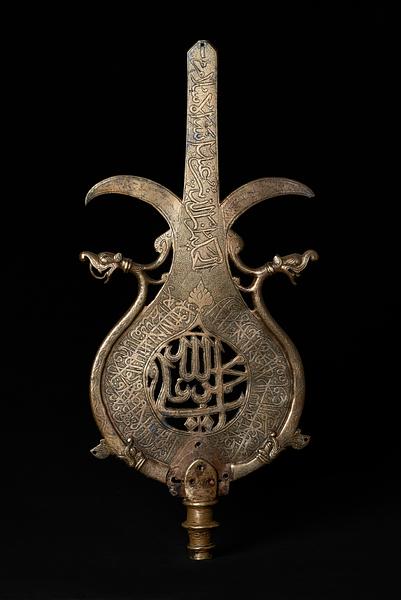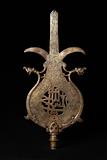Bronze standard with openwork decoration, engraved, chased, and inlaid with gold and silver
India, Deccan; 18th century
H: 45.5; Maximum W: 21 cm
Many of the sultanates in the Deccan had strong ties to Iran, among other things because they were predominantly Shiites, like the Safavids.
This standard is closely related to the more or less contemporary Iranian steel standards. Mounted on a pole, the standard could be used both by the military and for religious processions. The dragon heads, which are also found on Iranian standards, have been given an unmistakable Indian look. Above them are two arcs, a reference to Ali’s famous sword with a split blade. The name of this caliph, the first in the series of Shia Muslim imams, embellishes the central openwork section together with “Muhammad” and “Allah.”
Inv. no. 32/1971
Published in:
André Leth: Davids Samling. Islamisk kunst = The David Collection. Islamic Art, København 1975, p. 87;
Kjeld von Folsach: Islamic art. The David Collection, Copenhagen 1990, cat.no. 368;
Kjeld von Folsach: Fabelvæsner fra Islams Verden, Davids Samling, København 1991, cat.no. 51;
Kjeld von Folsach, Torben Lundbæk and Peder Mortensen (eds.): Sultan, Shah and Great Mughal: the history and culture of the Islamic world, The National Museum, Copenhagen 1996, cat.no. 177;
Mark Zebrowski: Gold, silver and bronze from Mughal India, London 1997, fig. 538 and p. 333;
Kjeld von Folsach: Art from the World of Islam in The David Collection, Copenhagen 2001, cat.no. 557;
Kjeld von Folsach, Joachim Meyer and Peter Wandel: Fighting, Hunting, Impressing. Arms and Armour from the Islamic World 1500-1850, The David Collection, Copenhagen 2021, cat.no. 14;


